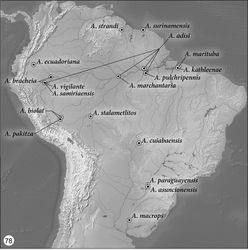Asklepia samiriaensis
| Notice: | This page is derived from the original publication listed below, whose author(s) should always be credited. Further contributors may edit and improve the content of this page and, consequently, need to be credited as well (see page history). Any assessment of factual correctness requires a careful review of the original article as well as of subsequent contributions.
If you are uncertain whether your planned contribution is correct or not, we suggest that you use the associated discussion page instead of editing the page directly. This page should be cited as follows (rationale):
Citation formats to copy and paste
BibTeX: @article{Erwin2014ZooKeys430, RIS/ Endnote: TY - JOUR Wikipedia/ Citizendium: <ref name="Erwin2014ZooKeys430">{{Citation See also the citation download page at the journal. |
Ordo: Coleoptera
Familia: Carabidae
Genus: Asklepia
Name
Asklepia samiriaensis Zamorano & Erwin sp. n. – Wikispecies link – ZooBank link – Pensoft Profile
Holotype
Perú, Loreto, Boca del Río Samiria, 1 km SW Vigilante post No. 1, 4.5005°S, 74.0659°W, 99m, 16 August 1991 (T.L. Erwin, M.G. Pogue)(MUSM: ADP051663, male).
Derivation of specific epithet
The specific epithet, samiriaensis, is a singular Latinized feminine noun in apposition, based on the name of the river near which these beetles were found.
Proposed english vernacular name
Samiria pattern-wing beetles.
Diagnosis
With the attributes of the genus Asklepia as described by Liebke (1938)[1] and as noted above under the generic diagnosis, and small-sized for the genus (SBL = 2.436 mm). Adults with head brunneus, prothorax flavotestaceous, elytral maculae fulvous; elytron fuscous with a small triangular flavous macula in the basal proximal quadrant reaching the sutural area, medial lateral quadrant fulvous, an enclosed ocellate flavous macula in the middle of medial proximal quadrant, a triangular flavous macula in the apical proximal quadrant, lateral and apical margins fulvous; abdominal sterna III-VI, and epipleuron fulvous, abdominal sternum VII fuscous; legs fulvous; antennal scape, pedicel and antennomere 3 testaceous, antennomeres 4-6 and basal half of 7 deeply infuscated, apical half of 7 and 8-11 white. Dorsal surface devoid of microsculpture, surface luster very shiny. Pronotum markedly convex with lateral margin effaced except just anterior to hind angle and there a simple bead; hind angle feebly produced, median line feebly defined. Elytral interneurs effaced from greater part of elytron surface, only evident as short discontinuous rows of spaced punctures at apical and basal sutural area, punctures fuscous.
Description
(Habitus, Fig. 51). Size: [See also Table 23] Medium-size for the genus; ABL = 2.853 mm, SBL = 2.436 mm, TW (total width) 1.274 mm, LP = 0.537 mm, WP = 0.613 mm, LE =1.503 mm. Color: See diagnosis above. Luster: See diagnosis above. Head (Fig. 51): as in description for genus above. Prothorax. Pronotum (Fig. 51) slightly broad, slightly narrower than head across eyes (WH/WP: 1.188), longer than head (LP/LH: 1.357), about as wide as long (W/L: 1.141); markedly cordiform and rounded, lateral margin effaced with seta at anterior third on slightly raised area; apex markedly constricted; anterior angles feebly produced, hind angle slightly produced and setose, median line feebly defined, basal margin fuscous; surface smooth throughout. Pterothorax. Normal for genus, see description for genus above. Elytra moderately convex; twice as wide as head across eyes (WH/TW: 0.571) and pronotum (WP/TW: 0.481), longer than wide. Elytral interneurs effaced from greater part of the elytron surface, only evident as short discontinuous rows of spaced punctures at apical and basal sutural area, punctures fuscous; elytron substantially transparent. Hind wings fully developed. Legs. Overall, normal for genus, see description for genus above. Abdominal sterna. Overall, normal for genus, see description for genus above. Male genitalia. Not investigated due to the fragile nature of the holotype. Female genitalia. Unknown.
Dispersal potential
These beetles are macropterous and probably capable of flight. They are moderately swift and agile runners.
Distribution
(Fig. 78). This species has been found at only one location on a black-water system of the upper Amazon River drainage system. But that does not at all indicate its real distribution: as has been pointed out above, very small beetles are inadequately sampled, especially in the Neotropics.
Way of life
See Erwin (1991)[2] for a general description. Adults of this species are active in the rainy season and occur in open grassy marshes.
Other specimens examined
None.
Original Description
- Erwin, T; Zamorano, L; 2014: A synopsis of the tribe Lachnophorini, with a new genus of Neotropical distribution and a revision of the Neotropical genus Asklepia Liebke, 1938 (Insecta, Coleoptera, Carabidae) ZooKeys, 430: 1-108. doi
Images
|

